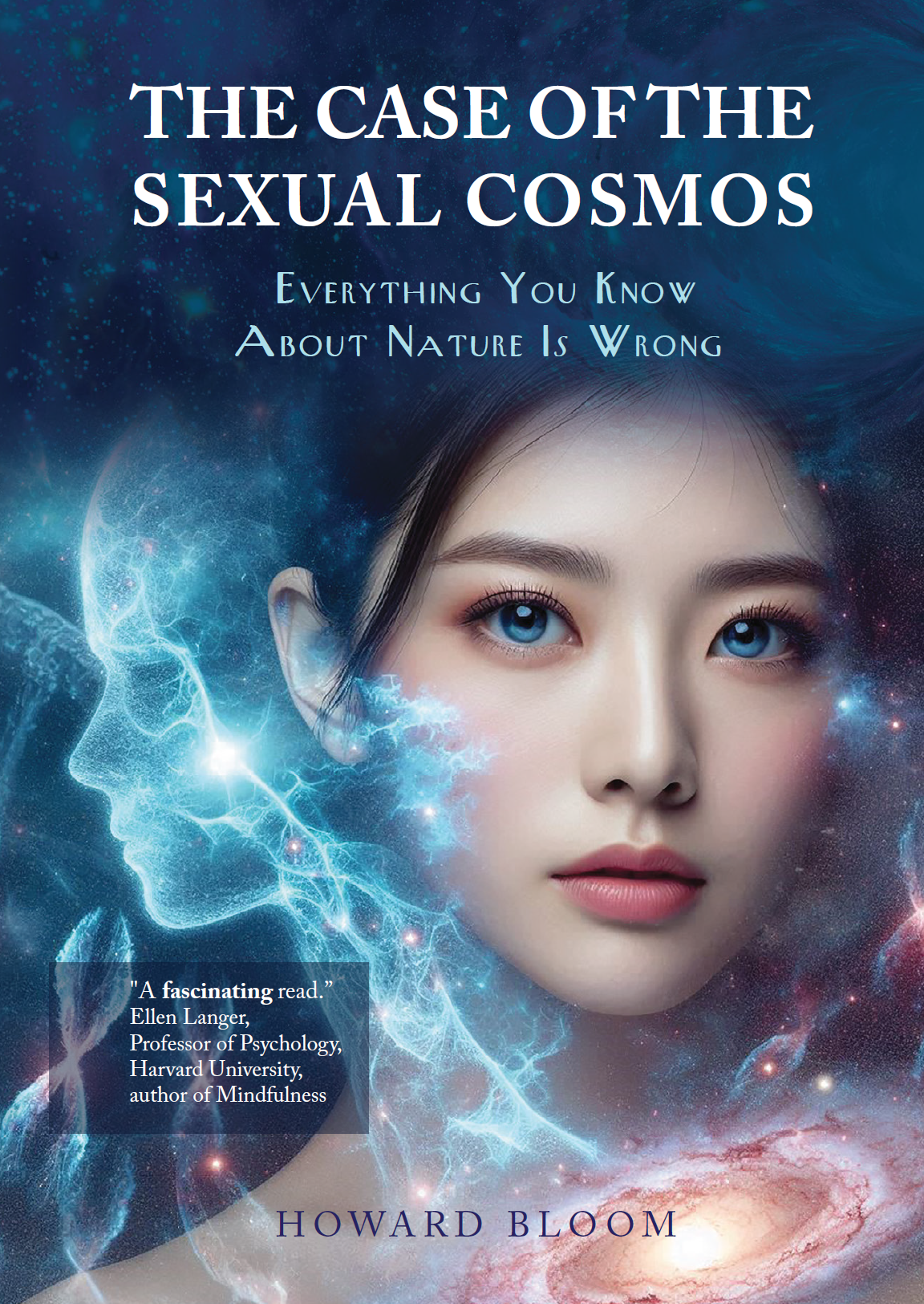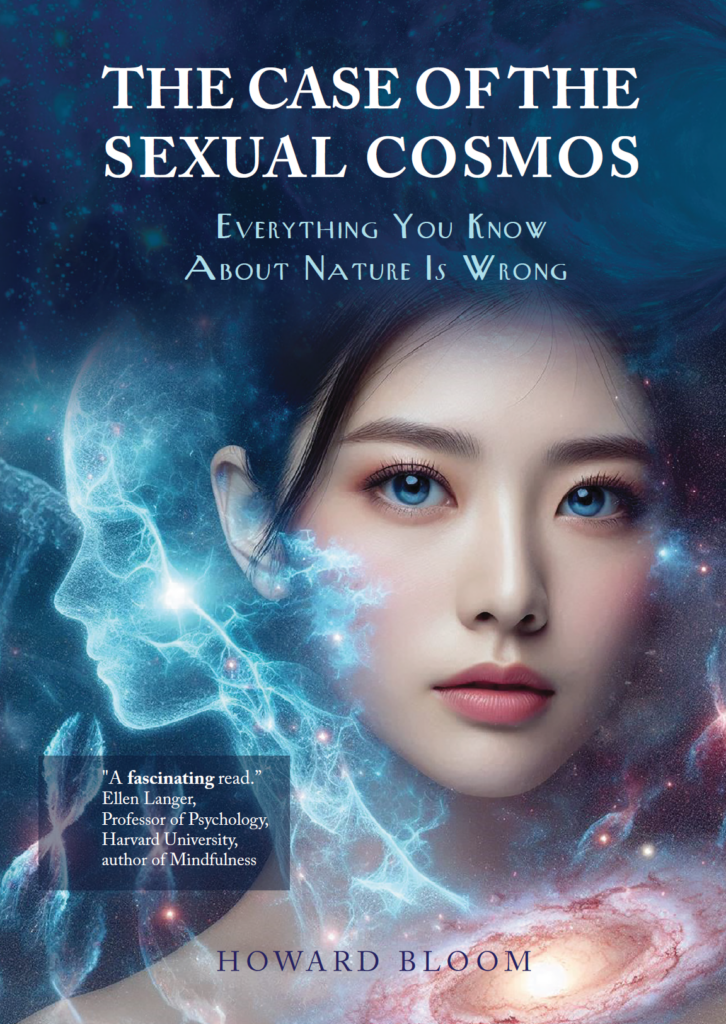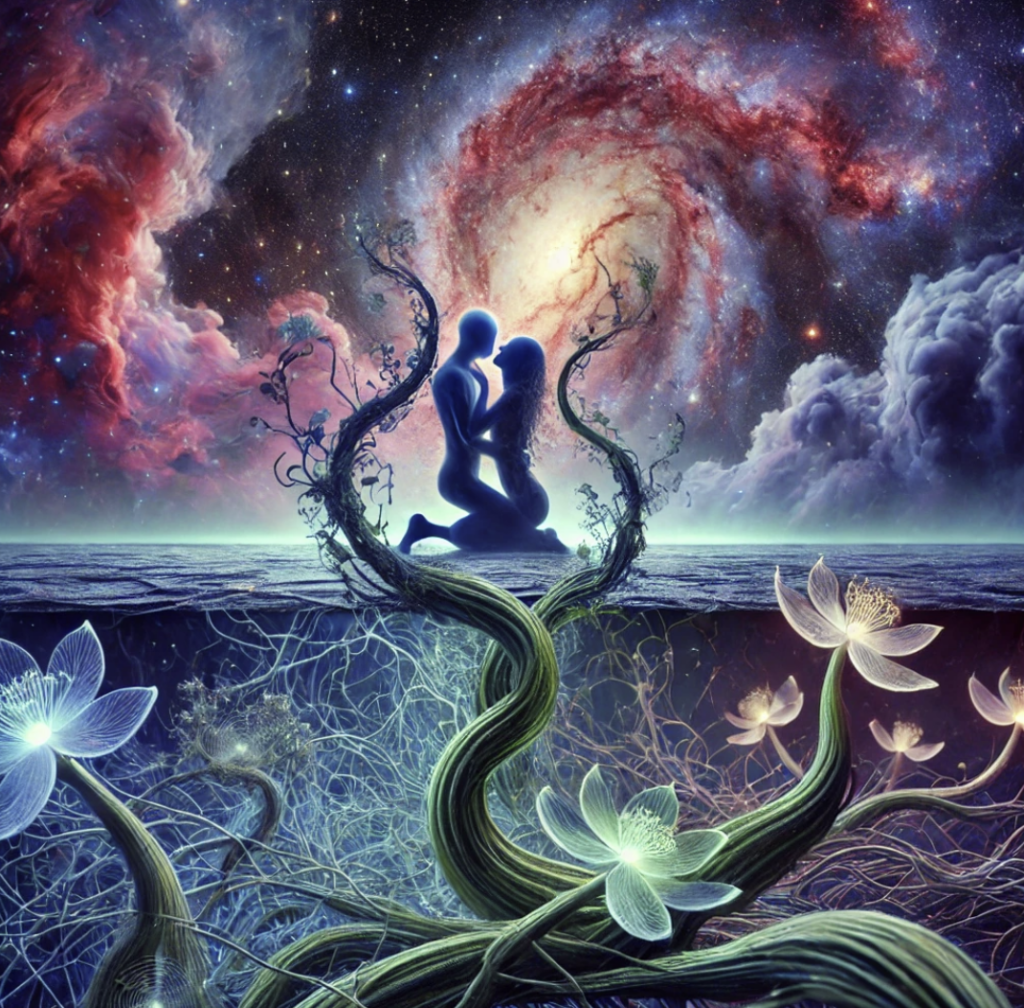
The Case for the Sexual Cosmos.
The Case for the Sexual Cosmos: Everything You Know About Nature is Wrong is Howard Bloom’s latest book. Bloom takes us on a grand journey from the emergence of the first bacteria, flowers, humanity, and all the way to stars and galaxies. Bloom shows how the forces that drive the universe and history connect you and me in what may be his wildest theory yet.

The Case for the Sexual Cosmos: Everything You Know About Nature is Wrong.
Right away, Bloom tackles key concepts taken as self-evident in the science world: the Second Law of Thermodynamics and entropy. The Second Law of Thermodynamics states that entropy indefinitely increases in the universe. Entropy is the level of chaos within any system and a tendency toward said chaos. A famous experiment demonstrated entropy. A sugar cube was dropped into a glass of water and it unsurprisingly dissolved, supposedly proving that the cosmos is entropic. Clearly existence is unpredictable, but Bloom finds the idea of an entropic dubious in the face of overwhelming evidence to the contrary.
Bloom believes there is a pervasive view in our culture that nature was a pristine paradise before humanity destroyed it. This view additionally portrays life as frugal and efficient. Bloom makes the case that life has been an unstable, chaotic proposition from day one and that greed, consumerism, capitalism, vanity, and waste aren’t evil, but catalysts for diversity.
Life’s mandate, Bloom says is to “kidnap, seduce, and recruit as many dead atoms as possible into the extraordinary enterprise of life.” This is exactly what the earliest life did.
birthed FROM catastrophe.
Earth three billion years ago was a brutal, desolate landscape. Environmental catastrophe has been the norm since life first emerged. The day and night cycle was the first catastrophe life had to contend with. Day and night lasted six hours each at the time. This caused massive surges and crashes in temperature. As if that wasn’t enough for bacteria, earth was pummeled by a non-stop blast of solar radiation and celestial rocks. On top of that, the atmosphere was a toxic stew of chemicals.
“Nature loves those who oppose her most” is a phrase littered throughout like a mantra. There have been five mass extinctions, so in order to survive creatures had to be as tough as nails. Bloom asserts that life wasn’t repelled by these harsh conditions, but instead thrived by turning poisons into food and building biochemical shields, which are essentially housing compounds for bacterial colonies. Bacteria also invented bio-chemical warfare. Right from the beginning, the evolution of bio-chemical shelter and warfare goes against the idea that the cosmos tends towards chaos.
sex is wasteful.
Plants invented a radical reproductive strategy: sex as we know it, with male and female cells. The first plants were mosses. Ancient mosses produced millions of male cells, sperm, and then discarded them in the hopes they’d pair with female eggs, ovule. Many, if not most, sperms never make it to an egg, yet mosses pour resources into sperm production.
Bloom refers to plants as nature’s first space program. Indeed, growing two inches off the ground was a major development for plants, but would evolve into an exorbitant commitment eventually. Trees are obviously a symbol of environmental conservation, but ironically they suck up resources like a diesel engine. For instance, every day thousands of gallons of water are pumped from the roots, all the way up to a tree’s extremities. That is one tree alone.
In addition, every spring a tree invests energy and resources into the growth of fresh leaves. In autumn the leaves die and fall to the ground, leaving litter, albeit beautiful litter. Why is this? As it turns out, careless deciduous trees have an edge over the comparatively conservative conifers, or pine trees. The rubbish created by deciduous trees enriches soil in a way that conifer trees simply can’t. Today there are over 2,000 species of deciduous trees and roughly 700 of conifers.
The First Law of Flamboyance.
According to Bloom’s First Law of Flamboyance, nature uses vain display and sex to create new nodes of interaction. These interactions create new organizational personalities and group identities. The flower is a prime example of the Law of Flamboyance and is truly the height of vanity and frivolity. Every year plants pour excessive resources into these ephemeral, colorful, perfumed, collections of delicate leaves. Why would nature invest in something so expensive, yet so temporary? Bloom says to this “Extravagance is an evolutionary accelerator. A creativity super-thruster.”
Long ago, flowers played a psychological trick on bees. Flowers lured bees with a pretty, aromatic display, enticingly saying to them “frolic through my stamen and get my pollen all over you. When you find the nectar you may eat.” Flowers turned bees into their pollen couriers, ensuring more flower reproduction. Bloom compares flowers to our McDonald’s, offering consumer bees bright colors and gastronomic delight in exchange for some brand loyalty.
Bees can visit up to 5,000 flowers a day. This seemingly capitalist ploy worked because today there are over 300,000 species of flowers.
Sex as a force of History.
Sex is a force not only driving evolution, but history as well Bloom illustrates. The courtship story of Anne Boleyn and Henry the VIII exemplifies this. Henry the VIII desperately wanted a son to inherit his crown and fell for Anne Boleyn. There was a problem however: Henry VIII was already married to Katherine of Aragon. Under rule of the papacy, the Pope, divorce was illegal. When Boleyn introduced Henry the VIII to a pamphlet by Martin Luther, the founder of Protestantism, everything changed. He realized there was a loophole to his dilemma and essentially declared himself the holy ruler of England. Now he would be able to get a divorce.
Their courtship was expensive, complex, and drawn out, leading to a wedding that was equally gaudy and extravagant. The point of this vanity, Bloom emphasizes, was to assert their authority. This level of complexity would not be possible in a universe that dissolves into chaos.
Boleyn and Henry the VIII sent violent ripples through English society. This act of defiance against the papacy led to brutal consequences, namely the cruel subjugation and executions of Catholics and Protestants. This defiance also led to a wholly new cultural identity. This shift led to the likes of William Shakespeare and indirectly led to the Age of Enlightenment.

The Case for the Sexual Cosmos.
Bloom calls stories like that of Henry the VIII and Anne Boleyn “hurricanes of history.” Bloom likens it to the way hurricanes, planets, and stars work. Hurricanes and gravitational bodies pull matter into their currents or orbit, gobbling up anything in its path, creating ever more complexity. Likewise, “hurricanes of history” are ideological battles that ensnare like-minded people to synthesize new group identities, which battle other group identities. Whichever group identity wins gobbles up the losers.
This brings us to the heart of things in the Case for the Sexual Cosmos. Entropy’s origins go back to the invention of the steam engine in the 19th Century. Mathematicians and engineers then couldn’t understand why energy put into steam engines was lost, eventually leading to the Theory of Thermodynamics. There is a hurricane of history happening right now between Reductionists and Holists Bloom says. Proponents of entropy are essentially Reductionists and believe reality is sussed by breaking things down to their smallest parts. Alternately, Holists believe that reality is best understood by observing and interacting with the world around you.
While Bloom is obviously critical of the Law of Thermodynamics, he does not support discarding it as a failed idea. To the contrary, he sees entropy as necessary, but incomplete. Bloom suggests that Reductionism has an undeserved influence on academia however and should be thoroughly scrutinized. His solution to the lopsidedness of academia is the field of study he invented called Omnology, which is described as being for the “promiscuously curious.” Omnology seeks to use every conceivable tool available for scientific inquiry to study life.
Life’s Mandate.
Environmentalism insists that the only solution to climate catastrophe is to be more conservative and use less resources. Bloom demonstrates beyond a shadow of a doubt why this can’t be correct. Nature wants us to take advantage of every possible resource at our disposal. The Case for the Sexual Cosmos proves that nature is anything but efficient or frugal. Life yearns for freedom, so who are we to stop her? Bloom eloquently demonstrates that the biggest threat to humanity is not climate catastrophe, but how we react to it. We cannot shrink away in fear, but must rise like the first mosses that left their oceanic incubator for the great, wide unknown.
Howard Bloom is a writer who lives in Park Slope. He has written eight books, including Case for the Sexual Cosmos, Global Brain and the Genius of the Beast. You can learn more about him and his cause at his website https://howardbloom.institute.
As always I, and the team at Brooklynites.NYC, thank you for reading. Click back soon. <3
Read more about Howard Bloom and his writing:
https://en.wikipedia.org/wiki/Howard_Bloom
More about entropy:
https://en.wikipedia.org/wiki/Entropy
More from Brooklynites:
https://brooklynites.nyc/the-brooklyn-bridge-made-new-york-city/
https://brooklynites.nyc/brooklyns-amusement-parks/
https://brooklynites.nyc/brooklyns-oldest-bars-2/
“


tempmails
“Thanks for sharing such valuable information!”